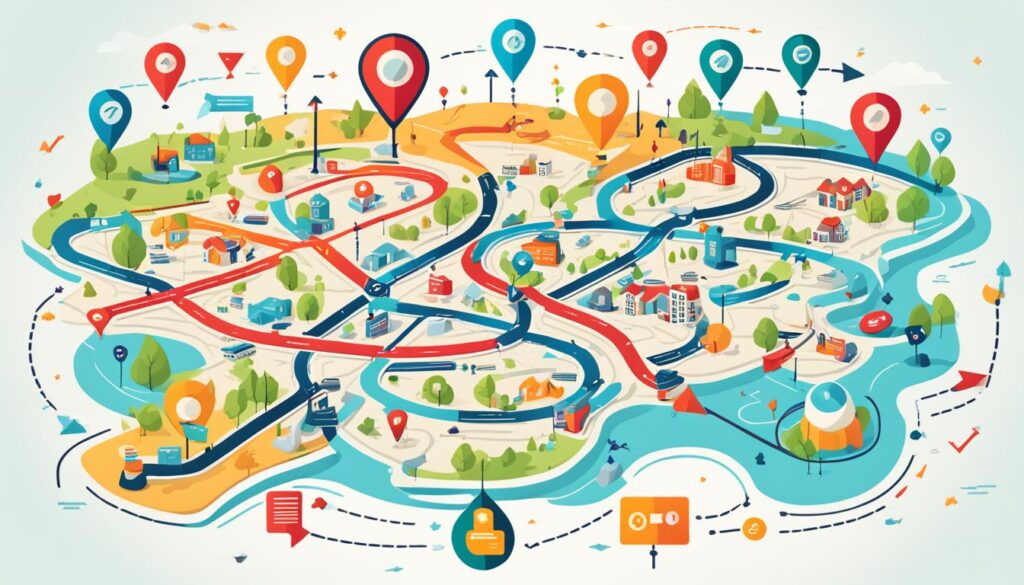Did you know that 80% of online experiences begin with a search engine? That’s a staggering number when you consider the vast amount of content available on the internet. With so much competition for attention, how can you ensure that your content stands out and reaches your target audience?
Enter content optimization – the key to increasing traffic, conversions, and reaching the right people. Content optimization involves refining your content to ensure it performs well with your target audience and helps you achieve your desired results. By employing strategies like keyword research, on-page optimization, and creating relevant content for social media and sales enablement, you can improve your chances of ranking in search engines, getting more mileage out of old content, and tailor your messaging to specific goals.
Key Takeaways:
- 80% of online experiences start with a search engine.
- Content optimization is essential for increasing traffic and conversions.
- By refining your content, you can tailor it to reach the right people.
- Employing content optimization strategies improves your chances of ranking in search engines.
- Content optimization allows you to get more value from your existing content.
What is Content Optimization?
Content optimization is the process of refining your content to ensure it performs well with your target audience and helps you reach your goals. By refining your content, you reduce the chances of creating content that goes unnoticed and increase its chances of success. Content optimization can be done for search engine optimization (SEO), social media, sales enablement, and conversions. The main objective is to refine your content in a way that helps you reach your desired goals.
When it comes to content optimization, it’s about more than just creating great content. It’s about tailoring that content to resonate with your target audience and drive the results you’re looking for. To achieve this, you need to refine your content to ensure it meets the needs and preferences of your target audience.
One way to refine your content is by understanding your target audience and their pain points. This involves gaining insights into who they are, what they care about, their challenges, and how they make decisions. By understanding your target audience, you can create content that addresses their specific needs and interests, making it more likely to resonate with them.
Another aspect of content optimization is refining your content to align with your goals. Whether your goal is to generate leads, increase sales, or improve brand awareness, you need to ensure that your content is crafted in a way that supports these objectives. This may involve incorporating strong calls to action, optimizing your content for specific keywords, or using persuasive language that encourages your audience to take the desired action.
Refining Your Content for Maximum Impact
When refining your content, it’s important to consider both the quality and relevance of your content. High-quality content that delivers value to your audience is more likely to be shared and engage your target audience. Additionally, ensuring that your content is relevant and tailored to the interests and needs of your target audience can make a significant difference in its performance.
Content optimization is a continuous process that involves analyzing data, testing different approaches, and refining your content based on the insights you gather. By regularly refining and optimizing your content, you can ensure that it continues to meet the changing needs and preferences of your target audience and helps you achieve your goals.
In the next section, we will explore why content optimization matters and the benefits it can bring to your business.
Why Content Optimization Matters

When it comes to creating and publishing content, optimization plays a crucial role in achieving our goals. Not only does it save us time, but it also increases the visibility of our content, allowing us to reach our target audience effectively.
By optimizing our content, we improve its chances of ranking higher in search engine results pages. This increased visibility means more organic traffic and potential conversions for our website. Additionally, by optimizing our content, we can make the most out of our existing content by reoptimizing it to fit current trends and preferences.
One of the key benefits of content optimization is the ability to tailor our content to our specific audience. By understanding their interests, preferences, and pain points, we can create content that resonates with them on a deeper level. This tailored approach helps us attract new visitors to our website and build a loyal following.
Content optimization empowers us to achieve our goals by aligning our content with our target audience and tailoring it to their needs. It ensures that our content is relevant, valuable, and impactful, leading to higher engagement, conversions, and overall success.
In the ever-evolving world of digital marketing, content optimization is a necessary practice to stay ahead. It allows us to adapt our content strategy based on the latest trends and algorithms, ensuring that we consistently deliver high-quality content that meets the expectations of our audience.
By investing time and effort into content optimization, we can refine our content to its fullest potential, increasing its impact, visibility, and ultimately, our success. It’s an essential component of a comprehensive content strategy that enables us to achieve our goals and establish credibility and trust with our audience. So let’s embrace content optimization and unleash the full potential of our content!
Continue reading to explore nine effective content optimization strategies that can take your content to the next level and help you achieve your objectives.
9 Content Optimization Strategies

When it comes to content optimization, there are several strategies you can implement to improve your chances of success. Depending on your content and brand, some key strategies to consider include:
- Strategic Keyword Usage: Incorporate keywords strategically throughout your content, including in the introductory paragraph, major headers, title, meta description, and page URL. This helps search engines understand the relevance of your content and improves your chances of ranking higher in search results.
- Meta Descriptions and Title Tags: Include compelling meta descriptions and title tags for each page to optimize for on-page SEO. These elements provide concise summaries and help search engines properly index and display your content.
- Technical Soundness: Ensure your website is technically sound by optimizing page load times, fixing broken links, using HTTPS, and improving mobile responsiveness. These technical optimizations contribute to better user experience and search engine rankings.
- Internal Linking: Create internal links within your content to direct users to other relevant pages on your website. This helps improve navigation, creates a hierarchical structure, and enhances the overall user experience.
- Breaking Up the Copy: Break up long paragraphs and chunks of text to make your content more visually appealing and easier to read. Use subheadings, bullet points, and numbered lists to organize information and improve readability.
By implementing these content optimization strategies, you can increase your visibility, improve search engine rankings, and provide a better user experience for your audience.
“Optimizing your content is not just about using keywords. It’s also about creating a seamless user experience and ensuring your website is technically sound.” – Neil Patel
Know Your Audience and Their Pain Points

To optimize your content effectively, it’s crucial to know your target audience and their pain points. Understanding who they are, what they care about, their challenges, and how they make decisions will inform your content strategy and increase its relevance. By tailoring your content to address their specific needs, you can capture their attention and drive engagement.
Additionally, conducting customer surveys can provide valuable feedback and help you uncover pain points that may not be obvious. By directly asking your audience about their challenges and preferences, you can gather valuable insights that will guide your content creation and improve customer satisfaction.
Keyword research is another essential tool in understanding your audience. By identifying the words and phrases they use when searching for information, you can create content that aligns with their interests and matches their search intent. Use keyword research tools to uncover relevant keywords and incorporate them strategically into your content.
Furthermore, analyzing your competitors’ content and strategies can provide valuable insights into what resonates with your target audience. By identifying successful topics, formats, and channels, you can adapt and improve your own content to better suit your audience’s preferences.
- Use buyer personas to understand your audience’s demographics, motivations, and behaviors.
- Conduct customer surveys to gather insights into their pain points and preferences.
- Perform keyword research to identify the words and phrases your audience uses.
- Analyze your competitors’ content and strategies to uncover successful tactics.
By utilizing these strategies, you can develop a deep understanding of your target audience and create personalized content that resonates with them. Content personalization based on buyer personas, customer surveys, and keyword research will help you optimize your content effectively and drive meaningful results.
Optimize Your Content for SEO and UX

To maximize the impact of your content, it’s essential to optimize it for both search engines and user experience. By incorporating SEO best practices and UX optimization techniques, you can ensure your content reaches a wider audience and provides a seamless user experience.
Incorporate SEO Optimization
Start by conducting thorough keyword research to identify the terms and phrases your target audience is searching for. Use these keywords strategically throughout your content, including in headings, subheadings, and meta tags. This will improve your content’s visibility and ranking in search engine results.
Consider using SEO plugins and analytics tools to gain insights into your website’s performance and identify areas for improvement. These tools can help you track your keyword rankings, identify backlink opportunities, and monitor user engagement metrics. By staying informed about your SEO performance, you can continuously optimize your content for better results.
Implement UX Best Practices
While SEO optimization is important, it’s equally crucial to prioritize the user experience. Use design tools to create visually appealing and engaging content layouts. Ensure your content is easily readable by utilizing readability tools that assess the complexity of your writing style, sentence structure, and word choice.
Test the usability and accessibility of your content using testing tools to ensure that it loads quickly, displays correctly on different devices, and is accessible to users with disabilities. By prioritizing user experience, you can keep your audience engaged and maximize the time they spend on your website.
Strive for a Perfect Balance
Remember, optimizing your content for both SEO and UX is not about choosing one over the other. The key is to find a perfect balance that enables your content to rank well in search engines while providing a seamless and enjoyable experience for your users.
By combining the power of SEO optimization and UX best practices, you can attract more organic traffic, increase user engagement, and achieve your content goals.
Conclusion
Optimizing content is essential for expanding our reach, accomplishing objectives, and producing content that truly engages our audience. By enhancing our content through precise keyword placement, focusing on SEO and UX improvements, and addressing our audience’s needs, we can boost visibility, drive traffic and conversions, and enhance trust and credibility.
Employing optimization strategies elevates our search engine positioning while guaranteeing a smooth user experience. Marrying SEO principles with UX design ensures our content is not only findable but also enjoyable for our viewers.
Moreover, by tapping into our audience’s challenges and customizing our content to address these issues, we forge a stronger bond with them, fostering significant impacts. From drawing in new visitors to converting prospects into dedicated customers, optimization is pivotal in realizing our objectives and cementing our online presence.
Thus, content optimization stands out as a pivotal approach in crafting influential content, attaining our ambitions, and establishing trust with our audience. Continual refinement and optimization guarantee our content excels, engaging the intended demographic and achieving our aims. Embracing content optimization as a fundamental facet of our digital marketing efforts unlocks our content’s true potential.
FAQ
What is content optimization?
It’s the process of tweaking your content to ensure it connects with your audience and fulfills your objectives effectively. This process encompasses keyword research, on-page tweaks, and crafting content suitable for social media and various conversion channels.
Why is content optimization important?
Optimizing content is key for time efficiency and enhancing content performance chances. It not only boosts content visibility and search engine rankings but also revamps existing content for better results. Optimization ensures content reaches and resonates with the intended audience, aiding in achieving specific targets, from attracting website visitors to converting leads into customers.
What strategies are involved in content optimization?
Effective strategies include strategic keyword use in vital content sections like the introduction, headers, title, meta description, and URL. Also, adding meta descriptions and title tags aids on-page SEO. Keeping your site technically optimized, creating internal links to related content, and segmenting copy to improve readability are also crucial strategies.
How can I identify my target audience and their issues?
Leverage buyer personas, customer surveys, and social media analytics for insights
About the Author
Justin Sirotin is not just any expert; he’s a beacon in SEO. His work at CNN laid a foundation for storytelling with impact. Now, at Super Massive, he’s pushing the boundaries of digital discovery.
Starting in journalism, he quickly realized the power of words. This led him to explore SEO, where he masters content optimization to enhance online presence.
His insight into the digital landscape is unmatched. This includes maximizing keywords and leveraging emerging technologies, making businesses thrive online.
For further reading, explore these productive resources he recommends:
- Long-tail keyword mapper for detailed SEO strategies.
- Voice optimization guide to catch up with the new search trends.
- SEO Schema guide for boosting content structure.
- Local SEO service guide to dominate local searches.
Sirotin empowers you to navigate the SEO world with easy and impactful strategies. Dive deeper into his methodologies and see your content reach its maximum potential.




